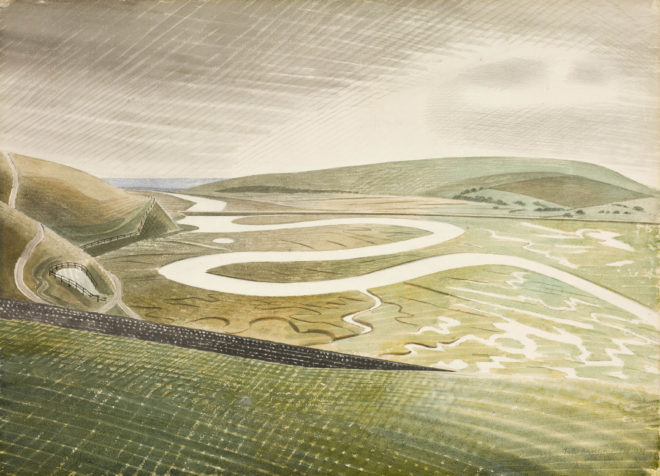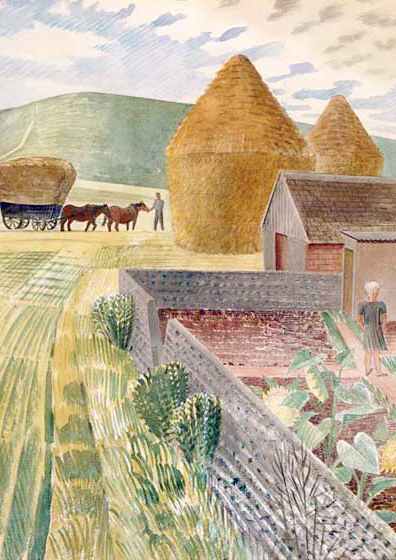Artist Eric Ravilious and the beauty of winter
January 14, 2021
Summer on the South Downs, with its wildflowers and ascending skylarks, might seem a distant memory at this time of year yet, for many lovers of this special landscape, wintertime has a beauty all of its own that holds a particular appeal.
Winter on the Downs was a time of year that entranced the painter and designer Eric Ravilious. Ravilious is one of those artists whose work is familiar, even if his name is not. His black-and-white drawing of gentleman cricketers graced the front cover of Wisden, the cricketer’s bible, for years. And many greeting cards bear his haunting images of the Eastbourne stretch of the Downs: pictures which capture beautifully the rolling landscape in winter with its chalk paths, dimple-like hollows and flint-strewn fields.

The Downs were known to Ravilious from childhood. He was a local boy who grew up in Eastbourne, in the early years of the twentieth century, where his father ran an antique shop. He went to Willingdon School, Eastbourne Grammar School and then Eastbourne College of Art. His best-known watercolours of the landscape were, however, painted after he had moved away to study design at the Royal College of Art.
Ravilious was drawn back to the area in the 1930s by his friend and fellow artist Peggy Angus. Angus had rented a shepherd’s cottage called Furlongs, nestling in the lee of Beddingham Hill near Newhaven. Known as ‘Red Angus’ for her socialist views, she was famed for the midsummer parties she held in the hollow of a dewpond above Furlongs. Here, her guests danced, sang folk songs and drank home-made elderflower champagne. Furlongs became a meeting place for a circle of artists, designers and architects that included painter John Piper and Serge Chermayeff, the architect of the De La Warr Pavilion in nearby Bexhill-on-Sea – as well as Ravilious.
It was from Furlongs that he set out on painting expeditions in all seasons with Angus, loaded down with easels and equipment. When out on the Downs, the two friends might well have, literally, crossed paths with members of the Bloomsbury Group, another, better-known, collection of artists and writers who were living, working and walking in the same area at that time. These included writer Virginia Woolf, who lived just a few miles across the River Ouse from Furlongs at Monk’s House in the village of Rodmell, and her sister, painter and designer Vanessa Bell, at Charleston near Firle. It’s intriguing that the two groups, just a stone’s throw from each other, didn’t mix: probably because they came from very different social backgrounds.

Furlongs, Ravilious said, “altered my whole outlook and way of painting”. He was entranced by the pared-back effect of the landscape in winter. His watercolours Downs in Winter and Chalk Paths, both from 1935, evoke its stark beauty: the muted greens, yellows and browns of the grassland; the play of light and shadow in wide, overcast skies; and the bare branches of hawthorn trees contorted by wind.
In these paintings, Ravilious captures perfectly the chalk so typical of this part of the Downs. He used what is sometimes called a ‘starved’ brush to achieve this, meaning that he didn’t flood the paper with a wash in the way water colourists normally do. This allowed the white flecks of the paper to show through, just as the chalk shows through the weathered turf.
Trained as a designer, Ravilious had a passion for patterns and saw them everywhere in this landscape: in the long lines of ploughed, harrowed or stubble fields criss-crossing each other; in the meandering chalk tracks worn into landscape by walkers; and in the twists and turns of the River Cuckmere snaking off towards the sea. There is a touch of melancholy in these paintings, further heightened by the lack of people. This is curious, since Ravilious was famously gregarious and fun-loving. He loved fireworks, boating and tennis and was known for always whistling. His friends called him ‘Rav’ or ‘The Boy’ as they felt the name Eric didn’t suit him.
Ravilious’s gift for finding beauty in the unexpected and for seeing patterns everywhere mean that his paintings can change the way we perceive the Downs at this time of year. A selection of Eric Ravilious’s paintings can be seen at the Towner Art Gallery in Eastbourne which houses many of his most significant works and has a gallery dedicated to him.
Dr Heloise Coffey
(images kindly provided by Towner Art Gallery)
- Would you like to contribute an article for the South Downs National Park’s newsletter? We’d love to feature informative pieces about the cultural heritage and biodiversity of the South Downs, or perhaps a personal piece about the what the Downs mean to you. Please contact newsletter@southdowns.gov.uk with ideas. Please note we reserve the right to edit, omit and curate all content submitted.
